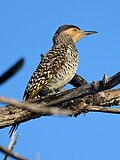| Colaptes | |
|---|---|

| |
| Gilded flicker (Colaptes chrysoides) | |
| Scientific classification | |
| Domain: | Eukaryota |
| Kingdom: | Animalia |
| Phylum: | Chordata |
| Class: | Aves |
| Order: | Piciformes |
| Family: | Picidae |
| Tribe: | Picini |
| Genus: | Colaptes Vigors, 1825 |
| Type species | |
| Cuculus auratus Linnaeus, 1758 | |
| Species | |
|
see text | |
| Synonyms | |
|
Chrysoptilus | |
Colaptes is a genus of birds in the woodpecker family Picidae. The 14 species are found across the Americas.
Colaptes woodpeckers typically have a brown or green back and wings with black barring, and a beige to yellowish underside, with black spotting or barring. There are usually colorful markings on the head. Many of these birds – particularly the northerly species – are more terrestrial than usual among woodpeckers.
Historically, there has been considerable uncertainty in assigning woodpecker species to genera and it is only by comparing DNA sequences that it has become possible to confidently place many of the species.
Taxonomy
The genus Colaptes was introduced by the Irish zoologist Nicholas Aylward Vigors in 1825 with the northern flicker (Colaptes auratus) as the type species. The name is from the Ancient Greek κολάπτης (kolaptēs) meaning "chiseller".
The genus forms part of the woodpecker subfamily Picinae and has a sister relationship to the genus Piculus. The genus Colaptes is a member of the tribe Picini and belongs to a clade that contains five genera: Colaptes, Piculus, Mulleripicus, Dryocopus and Celeus. Some of the relationships between the species within Colaptes are uncertain, with various genetic studies reporting slightly different phylogenies, but it is evident that those species with "flicker" in their common name do not form a monophyletic group.
The genus Colaptes contains 14 species. Of these, one species, the Bermuda flicker, is now extinct:
| Image | Common name | Scientific name | Distribution |
|---|---|---|---|
 |
Golden-olive woodpecker | Colaptes rubiginosus | east to Guyana, northwestern Argentina, Trinidad and Tobago |
 |
Bronze-winged woodpecker | Colaptes aeruginosus | northeastern Mexico from Tamaulipas to northern Veracruz |
 |
Grey-crowned woodpecker | Colaptes auricularis | Mexico |
 |
Crimson-mantled woodpecker | Colaptes rivolii | Bolivia, Colombia, Ecuador, Peru and Venezuela |
 |
Black-necked woodpecker | Colaptes atricollis | Peru |
 |
Spot-breasted woodpecker | Colaptes punctigula | Bolivia, Brazil, Colombia, Ecuador, French Guiana, Peru, Suriname and Venezuela; also in eastern Panama |
 |
Green-barred woodpecker | Colaptes melanochloros | Argentina, Bolivia, Brazil, Paraguay and Uruguay |
 |
Northern flicker | Colaptes auratus | North America, Cuba, the Cayman Islands, and parts of Central America |
 |
Gilded flicker | Colaptes chrysoides | southwestern United States and northwestern Mexico |
 |
Fernandina's flicker | Colaptes fernandinae | Cuba |
 |
Chilean flicker | Colaptes pitius | Argentina and Chile |
 |
Andean flicker | Colaptes rupicola | Peru, Chile, eastern Bolivia and northeastern Argentina |
 |
Campo flicker | Colaptes campestris | Brazil, Bolivia, Paraguay, Uruguay and northeastern Argentina, Suriname |
- † Bermuda flicker (Colaptes oceanicus) – extinct, but may have survived into historical times - formerly Bermuda
The online edition of the Handbook of the Birds of the World has split five of the species listed above to give a total of 20 species in the genus. None of the splits were based on results of molecular genetic studies. In addition, the common name of the northern flicker (Colaptes auratus) was changed to the "yellow-shafted flicker". These splits have not been adopted by the online edition of the Clements Checklist of Birds of the World maintained by ornithologists at Cornell University, nor by the American Ornithological Society.
References
- "Picidae". aviansystematics.org. The Trust for Avian Systematics. Retrieved 2023-07-26.
- Vigors, Nicholas Aylward (1825). "Observations on the natural affinities that connect the orders and families of birds". Transactions of the Linnean Society of London. 14 (#3): 395-517 . doi:10.1111/j.1095-8339.1823.tb00098.x.
- Jobling, James A. (2010). The Helm Dictionary of Scientific Bird Names. London: Christopher Helm. p. 113. ISBN 978-1-4081-2501-4.
- ^ Shakya, S.B.; Fuchs, J.; Pons, J.M.; Sheldon, F.H. (2017). "Tapping the woodpecker tree for evolutionary insight". Molecular Phylogenetics and Evolution. 116: 182–191. Bibcode:2017MolPE.116..182S. doi:10.1016/j.ympev.2017.09.005. PMID 28890006.
- Moore, W.S.; Overton, L.C.; Miglia, K.J. (2011). "Mitochondrial DNA based phylogeny of the woodpecker genera Colaptes and Piculus, and implications for the history of woodpecker diversification in South America". Molecular Phylogenetics and Evolution. 58 (#1): 76–84. Bibcode:2011MolPE..58...76M. doi:10.1016/j.ympev.2010.09.011. PMID 20863898.
- Dufort, Matthew J. (2016). "An augmented supermatrix phylogeny of the avian family Picidae reveals uncertainty deep in the family tree". Molecular Phylogenetics and Evolution. 94 (Pt A): 313–326. Bibcode:2016MolPE..94..313D. doi:10.1016/j.ympev.2015.08.025. PMID 26416706.
- Gill, Frank; Donsker, David, eds. (2019). "Woodpeckers". World Bird List Version 9.2. International Ornithologists' Union. Retrieved 10 August 2019.
- del Hoyo, Joseph (ed.). "Taxonomic structure and notes. Species list: Colaptes". Handbook of the Birds of the World Alive. Lynx Edicions. Retrieved 9 August 2019.
- "Clements Checklist". Cornell Lab of Ornithology. Retrieved 9 August 2019.
- "Checklist of North and Middle American Birds". American Ornithological Society. Retrieved 9 August 2019.
- "A Classification of the Bird Species of South America: Part 5. Trogoniformes to Psittaciformes". American Ornithological Society. Retrieved 9 August 2019.
External links
- [REDACTED] Media related to Colaptes at Wikimedia Commons
| Taxon identifiers | |
|---|---|
| Colaptes |
|







